April 27, 2015 — Editor’s note: This story was produced in collaboration with the Food & Environment Reporting Network, a non-profit investigative news organization.
Midway through spring, the nearly bare planting beds of Carolyn Leadley’s Rising Pheasant Farms, in the Poletown neighborhood of Detroit, barely foreshadow the cornucopian abundance to come. It will be many months before Leadley is selling produce from this one-fifth-acre (one-tenth-hectare) plot. But the affable young farmer has hardly been idle, even during the snowiest days of winter. Twice daily, she has been trekking from her house to a small greenhouse in her side yard, where she waves her watering wand over roughly 100 trays of sprouts, shoots and microgreens. She sells this miniature bounty, year round, at the city’s eastern market and to restaurateurs delighted to place some hyperlocal greens on their guests’ plates.
Leadley is a key player in Detroit’s vibrant communal and commercial farming community, which in 2014 produced nearly 400,000 pounds (181,000 kilograms) of produce — enough to feed more than 600 people — in its more than 1,300 community, market, family and school gardens. Other farms in postindustrial cities are also prolific: In 2008, Philadelphia’s 226 community and squatter gardens grew roughly 2 million pounds of mid-summer vegetables and herbs, worth US$4.9 million. Running at full bore, Brooklyn’s Added-Value Farm, which occupies 2.75 acres, funnels 40,000 pounds of fruit and vegetables into the low-income neighborhood of Red Hook. And in Camden, New Jersey — an extremely poor city of 80,000 with only one full-service supermarket — community gardeners at 44 sites harvested almost 31,000 pounds (14,000 kilograms) of vegetables during an unusually wet and cold summer. That’s enough food during the growing season to feed 508 people three servings a day.

In addition to raising vegetables, urban gardens can help families raise kids who enjoy the outdoors. Photo of Rising Pheasant Farms’ Carolyn Leadley and family by Marcin Szczepanski.
That researchers are even bothering to quantify the amount of food produced on tiny city farms — whether community gardens, like those of Camden and Philly, or for-profit operations, like Leadley’s — is testament to the nation’s burgeoning local-foods movement and its data-hungry supporters. Young farmers are, in increasing numbers, planting market gardens in cities, and “local” produce (a term with no formal definition) now fills grocery shelves across the U.S., from Walmart to Whole Foods, and is promoted in more than 150 nations around the world.
The Food and Agriculture Organization of the United Nations reports that 800 million people worldwide grow vegetables or fruits or raise animals in cities, producing what the Worldwatch Institute reports to be an astonishing 15 to 20 percent of the world’s food. In developing nations, city dwellers farm for subsistence, but in the U.S., urban ag is more often driven by capitalism or ideology. The U.S. Department of Agriculture doesn’t track numbers of city farmers, but based on demand for its programs that fund education and infrastructure in support of urban-ag projects, and on surveys of urban ag in select cities, it affirms that business is booming. How far — and in what direction — can this trend go? What portion of a city’s food can local farmers grow, at what price, and who will be privileged to eat it? And can such projects make a meaningful contribution to food security in an increasingly crowded world?
Urban Advantages
Like anyone who farms in a city, Leadley waxes eloquent on the freshness of her product. Pea shoots that have traveled 3 miles (4.8 kilometers) to grace a salad are bound to taste better and be more nutritious, she says, than those that have traveled half a continent or farther. “One local restaurant that I sell to used to buy its sprouts from Norway,” Leadley says. Fresher food also lasts longer on shelves and in refrigerators, reducing waste.
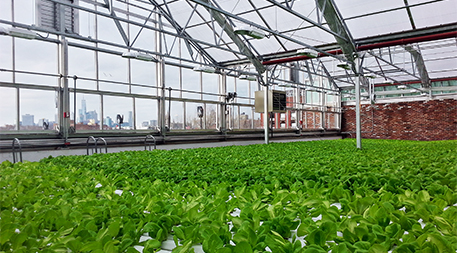
New York City–based Gotham Greens produces more than 300 tons per year of herbs and greens in two hydroponic facilities. Photo by TIA (Flickr/Creative Commons)
Food that’s grown and consumed in cities has other advantages: During times of abundance, it may cost less than supermarket fare that’s come long distances, and during times of emergency — when transportation and distribution channels break down — it can fill a vegetable void. Following large storms such as Hurricane Sandy and the blizzards of this past winter, says Viraj Puri, cofounder of New York City–based Gotham Greens (which produces more than 300 tons (270 metric tons) of herbs and microgreens per year in two rooftop hydroponic operations and has another farm planned for Chicago), “our produce was the only produce on the shelf at many supermarkets across the city.”
Despite their relatively small size, urban farms grow a surprising amount of food, with yields that often surpass those of their rural cousins. This is possible for a couple reasons. First, city farms don’t experience heavy insect pressure, and they don’t have to deal with hungry deer or groundhogs. Second, city farmers can walk their plots in minutes, rather than hours, addressing problems as they arise and harvesting produce at its peak. They can also plant more densely because they hand cultivate, nourish their soil more frequently and micromanage applications of water and fertilizer.
As social enterprises, community gardens operate in an alternate financial universe: they don’t sustain themselves with sales, nor do they have to pay employees.Though they don’t get as much press as for-profit farms and heavily capitalized rooftop operations, community gardens — which are collectively tended by people using individual or shared plots of public or private land, and have been a feature in U.S. cities for well over a century — are the most common form of urban agriculture in the nation, producing far more food and feeding more people, in aggregate, than their commercial counterparts. As social enterprises, community gardens operate in an alternate financial universe: they don’t sustain themselves with sales, nor do they have to pay employees. Instead, they rely on volunteer or cheap youth labor, they pay little or nothing in rent, and they solicit outside aid from government programs and foundations that support their social and environmental missions. These may include job training, health and nutrition education, and increasing the community’s resilience to climate change by absorbing stormwater, counteracting the urban heat island effect and converting food waste into compost.
Funders don’t necessarily expect community gardens to become self-sustaining. These farms may increase their revenue streams by selling at farmers markets or to restaurants, or they may collect fees from restaurants or other food-waste generators for accepting scraps that will be converted into compost, says Ruth Goldman, a program officer at the Merck Family Fund, which funds urban agriculture projects. “But margins on vegetable farming are very slim, and because these farms are doing community education and training teen leaders, they’re not likely to operate in the black.”
[I]t’s the microgreens that keep Leadley from joining the ranks of the vast majority of U.S. farmers and taking a second job.Several years ago, Elizabeth Bee Ayer, who until recently ran a training program for city farmers, took a hard look at the beets growing in her Youth Farm, in the Lefferts Gardens neighborhood of Brooklyn. She counted the hand movements involved in harvesting the roots and the minutes it took to wash and prepare them for sale. “Tiny things can make or break a farm,” Ayer notes. “Our beets cost US$2.50 for a bunch of four, and people in the neighborhood loved them. But we were losing 12 cents on every beet.” Ultimately, Ayer decided not to raise the price: “No one would have bought them,” she says. Instead, she doubled down on callaloo, a Caribbean herb that cost less to produce but sold enough to subsidize the beets. “People love it, it grows like a weed, it’s low maintenance and requires very little labor.” In the end, she says, “We are a nonprofit, and we didn’t want to make a profit.”
Sustainable and Resilient
Few would begrudge Ayer her loss leader, but such practices can undercut for-profit city farmers who are already struggling to compete with regional farmers at crowded urban markets and with cheap supermarket produce shipped from California and Mexico. Leadley, of Rising Pheasant Farms, realized long ago that she wouldn’t survive selling only the vegetables from her outdoor garden, which is why she invested in a plastic-draped greenhouse and heating system. Her tiny shoots, sprouts, amaranth and kohlrabi leaves grow year-round; they grow quickly — in the summer, Leadley can make a crop in seven days — and they sell for well over a dollar an ounce.
Nodding toward her backyard plot, Leadley says, “I grow those vegetables because they look good on the farm stand. They attract more customers to our table, and I really love growing outdoors.” But it’s the microgreens that keep Leadley from joining the ranks of the vast majority of U.S. farmers and taking a second job.
Mchezaji Axum, an agronomist with the University of the District of Columbia, the first exclusively urban land-grant university in the nation, helps urban farmers increase their yields whether they are selling into wealthy markets, like Leadley, or poorer markets, like Ayer. He promotes the use of plant varieties adapted to city conditions (short corn that produces four instead of two ears, for example). He also recommends biointensive methods, such as planting densely, intercropping, applying compost, rotating crops and employing season-extension methods (growing cold-tolerant vegetables like kale, spinach or carrots in winter hoop houses, for example, or starting plants in cold frames — boxes with transparent tops that let in sunlight but protect plants from extreme cold and rain).
“You learn to improve your soil health, and you learn how to space your plants to get more sunshine,” Axum says. Surveying D.C.’s scores of communal gardens, Axum has been surprised by how little food they actually grow. “People aren’t using their space well. More than 90 percent aren’t producing intensively. Some people just want to grow and be left alone.
“Using biointensive methods may not be part of your cultural tradition,” Laura J. Lawson, a professor of landscape architecture at Rutgers State University and the author of City Bountiful: A Century of Community Gardening in America, says. “It depends who you learned gardening from.” Lawson recalls the story of a well-meaning visitor to a Philadelphia garden who suggested that the farmers had planted their corn in a spot that wasn’t photosynthetically ideal. The women told their visitor, “We always plant it there; that way we can pee behind it.”
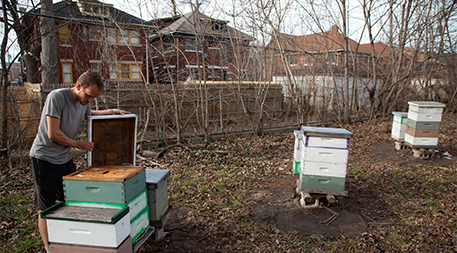
Noah Link checks on his bees at Food Field, a commercial farm in Detroit. Photo by Marcin Szczepanski.
Axum is all about scaling up and aggregating hyperlocal foods to meet the demands of large buyers like city schools, hospitals or grocery stores. Selling to nearby institutions, say food policy councils — established by grassroots organizations and local governments to strengthen and support local food systems — is key to making urban food systems more sustainable and resilient, to say nothing of providing a living to local growers. But scaling up often requires more land, and therefore more expensive labor to cultivate it, in addition to changes in local land use and other policies, marketing expertise and efficient distribution networks.
“Lots of local institutions want to source their food here,” says Detroit farmer Noah Link, whose Food Field, a commercial operation, encompasses a nascent orchard, vast areas of raised beds, two tightly wrapped 150-foot (46-meter)-long hoop houses (one of which shelters a long, narrow raceway crammed with catfish), chickens, beehives and enough solar panels to power the whole shebang. “But local farms aren’t producing enough food yet. We’d need an aggregator to pull it together for bulk sales.”
Link doesn’t grow microgreens — the secret sauce for so many commercial operations — because he can break even on volume: His farm occupies an entire city block. Annie Novak, who co-founded New York City’s first for-profit rooftop farm in 2009, doesn’t have the luxury of space. She realized early on that she couldn’t grow a wide enough diversity of food to satisfy her community-supported agriculture customers in just 5,800 square feet (540 square meters) of shallow raised beds. “So I partnered with a farm upstate to supplement and diversify the boxes,” she says. Now, Novak focuses on niche and value-added products. “I make a hot sauce from my peppers and market the bejesus out of it,” she says. She also grows microgreens for restaurants, plus honey, herbs, flowers and “crops that are narratively interesting, like purple carrots, or heirloom tomatoes, which give us an opportunity to educate people about the value of food, green spaces and our connection to nature,” she says.
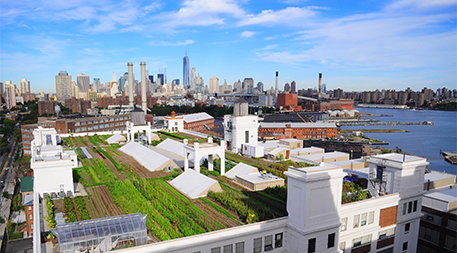
Brooklyn Grange in New York grows more than 50,000 pounds of produce each year in its rooftop gardens. Photo © Brooklyn Grange Rooftop Farm / Anastasia Cole Plakias.
Sometimes being strategic with crop selection isn’t enough. Brooklyn Grange, a for-profit farm atop two roofs in New York City, grows more than 50,000 pounds (23,000 kilograms) of tomatoes, kale, lettuce, carrots, radishes and beans, among other crops, each year. It sells them through its CSA, at farm stands and to local restaurants. But to further boost its income, Brooklyn Grange also offers a summerlong training program for beekeepers (US$850 tuition), yoga classes and tours, and it rents its Edenic garden spaces, which have million-dollar views of the Manhattan skyline, for photo shoots, weddings, private dinners and other events.
“Urban farms are like small farms in rural areas,” says Carolyn Dimitri, an applied economist who studies food systems and food policy at New York University. “They have the same set of problems: people don’t want to pay a lot for their food, and labor is expensive. So they have to sell high-value products and do some agritourism.”
Under Control
On a miserable March morning, with a sparkling layer of ice glazing a foot of filthy snow, a coterie of Chicago’s urban farmers toils in shirtsleeves and sneakers, their fingernails conspicuously clean. In their gardens, no metal or wood scrap accumulates in corners, no chickens scratch in hoop-house soil. In fact, these farmers use no soil at all. Their densely planted basil and arugula leaves sprout from growing medium in barcoded trays. The trays sit on shelves stacked 12 feet (3.7 meters) high and illuminated, like tanning beds, by purple and white lights. Fans hum, water gurgles, computer screens flicker.
[W]ith 25 high-density crops per year, as opposed to a conventional farmer’s five or so, CEA yields are 10 to 20 times higher than the same crop grown outdoors.FarmedHere, the nation’s largest player in controlled environment agriculture — CEA —pumps out roughly a million pounds (500,000 kilograms) per year of baby salad greens, basil and mint in its 90,000-square-foot (8,000-square-meter) warehouse on the industrial outskirts of Chicago. Like many hydroponic or aquaponic operations (in which water from fish tanks nourishes plants, which filter the water before it’s returned to the fish), the farm has a futuristic feel — all glowing lights and stainless steel. Employees wear hairnets and nitrile gloves. But without interference from weather, insects or even too many people, the farm quickly and reliably fulfills year-round contracts with local supermarkets, including nearly 50 Whole Foods Markets.
“We can’t keep up with demand,” Nick Greens, a deejay turned master grower, says.
Unlike outdoor farms, CEA has no call for pesticides and contributes no nitrogen to waterways. Its closed-loop irrigation systems consume 10 times less water than conventional systems. And with 25 high-density crops per year, as opposed to a conventional farmer’s five or so, CEA yields are 10 to 20 times higher than the same crop grown outdoors — in theory sparing forests and grasslands from the plow.
Is CEA the future of urban farming? It produces a lot of food in a small space, to be sure. But until economies of scale kick in, these operations — which are capital intensive to build and maintain — must concentrate exclusively on high-value crops like microgreens, winter tomatoes and herbs.
Reducing food miles reduces transit-related costs, as well as the carbon emissions associated with transport, packaging and cooling. But growing indoors under lights, with heating and cooling provided by fossil fuels, may negate those savings. When Louis Albright, an emeritus professor of biological and environmental engineering at Cornell University, dug into the numbers, he discovered that closed-system farming is expensive, energy intensive and, at some latitudes, unlikely to survive on solar or wind power. Growing a pound of hydroponic lettuce in Ithaca, New York, Albright reports, generates 8 pounds (4 kilograms) of carbon dioxide at the local power plant: a pound of tomatoes would generate twice that much. Grow that lettuce without artificial lights in a greenhouse and emissions drop by two thirds.
Food Security
In the world’s poorest nations, city dwellers have always farmed for subsistence. But more of them are farming now than ever before. In Africa, for example, it’s estimated that 40 percent of the urban population is engaged in agriculture. Long-time residents and recent transplants alike farm because they’re hungry, they know how to grow food, land values in marginal areas (under power lines and along highways) are low, and inputs like organic wastes — fertilizer — are cheap. Another driver is the price of food: People in developing nations pay a far higher percentage of their total income for food than Americans do, and poor transportation and refrigeration infrastructure make perishable goods, like fruits and vegetables, especially dear. Focusing on these high-value crops, urban farmers both feed themselves and supplement their incomes.
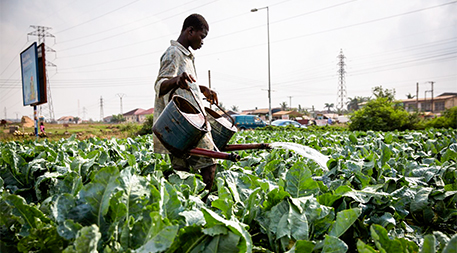
Urban farming is common in Ghana and other sub-Saharan countries. Photo by Nana Kofi Acquah/IMWI
In the U.S., urban farming is likely to have its biggest impact on food security in places that, in some ways, resemble the global south — that is, in cities or neighborhoods where land is cheap, median incomes are low and the need for fresh food is high. Detroit, by this metric, is particularly fertile ground. Michael Hamm, a professor of sustainable agriculture at Michigan State University, calculated that the city, which has just under 700,000 residents and more than 100,000 vacant lots (many of which can be purchased, thanks to the city’s recent bankruptcy, for less than the price of a refrigerator), could grow three quarters of its current vegetable consumption and nearly half its fruit consumption on available parcels of land using biointensive methods.
No one expects city farms in the U.S. to replace peri-urban or rural vegetable farms: cities don’t have the acreage or the trained farmers, and most can’t produce food anything close to year-round. But can city farms take a bite from long-distance supply chains? NYU’s Dimitri doesn’t think so. Considering the size and global nature of the nation’s food supply, she says, urban ag in our cities “isn’t going to make a dent. And it’s completely inefficient, economically. Urban farmers can’t charge what they should, and they’re too small to take advantage of economies of scale and use their resources more efficiently.”
That doesn’t mean that community gardeners, who don’t even try to be profitable, aren’t making a big difference in their immediate communities. Camden’s 31,000 pounds (14,000 kilograms) of produce might not seem like a lot, but it’s a very big deal for those lucky enough to get their hands on it. “In poor communities where households earn very little income,” says Domenic Vitiello, an associate professor of city and regional planning at the University of Pennsylvania, “a few thousand dollars’ worth of vegetables and fruit grown in the garden makes a much bigger difference than for more affluent households.”
History tells us that community gardening — supported by individuals, government agencies and philanthropies — is here to stay. And whether these gardens ultimately produce more food or more knowledge about food — where it comes from, what it takes to produce it, how to prepare and eat it — they still have enormous value as gathering places and classrooms and as conduits between people and nature. Whether or not cultivating fruits and vegetables in tiny urban spaces makes economic or food-security sense, people who want to grow food in cities will find a way to do so. As Laura Lawson says, “City gardens are part of our ideal sense of what a community should be. And so their value is priceless.”
![]()
UPDATED 05.06.15: A source was added for the percent of global food grown in cities.
Ensia shares solutions-focused stories free of charge through our online magazine and partner media. That means audiences around the world have ready access to stories that can — and do — help them shape a better future. If you value our work, please show your support today.
Yes, I'll support Ensia!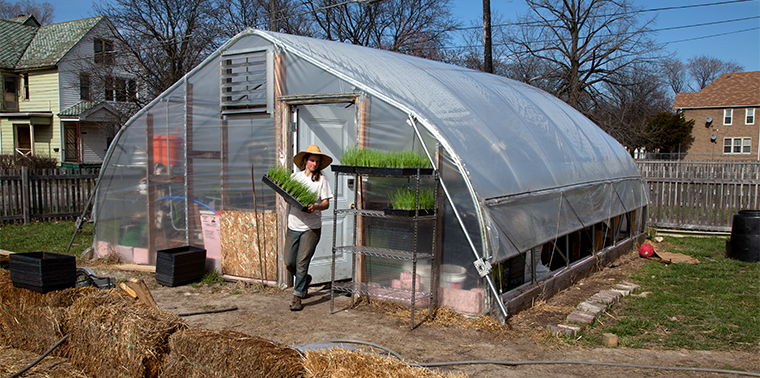

compost from yard waste. This super soil grows wonderful organic crops that are well received by consumers at local farmers markets. People work and make money doing this! I'm pleased to say that I provided the compost and made money for my work!! We love it! Yes, regular folks need to make a living!
Not urban farms, just people wanting a healthy lifestyle.
The past 100 years of urban farming cycles correlated to world wars and economic downturns. While it temporarily helped communities get through hard times, it never became a significant source of production or provided a serious alternative to the industrialized food system. For this time to be different, and for urban agriculture to have measurable impact, it needs to work as a business.
On the flip side, if it gets more people growing their own food, it has some value. However, you might notice that Margaret Atwood's urban farmers in the MaddAdam post-apocalyptic series were doing things on a much more "manual" level. That is the real vision of the future of urban farming. Of course it is not as sexy as the techniques described in the article.
I live in the SF Bay Area and real estate is precious. Granted, the community gardens and school programs are great and certainly raise awareness of the role of fresh healthy food in our lives, but as the article points out, it only goes so far. Urban agriculture has many benefits from better health of those who consume the produce to more connection to local commerce. These “positive externalities” are something of tangible, but not recognized economic value.
I guess as I ponder this article, I am left with the following questions: are there entities out there making it on a significant scale? Have there been scenarios from the past where we've been able to feed ourselves and make a living at this same time. If so, how do we get there?
So? Perspective, man. No one who complains about carbon footprints ever seems to take into consideration that military vehicles, jets, ships, tanks etc are all spewing way more waste products than ordinary people/civilians trying to create a positive future ever could. Maybe you ought to criticize the real problem instead of trashing people trying to do something constructive instead of mindlessly destructive.
I do though, agree that Walter Haugen, misplaces his aggression. Walter, there is a simple fact that the intensive agriculture technologies have not developed to the point of economic ROI that the very inferior product producing and destructive current state of Agricultural technology has. Some of these alternative production systems are using tech that requires a high 'carbon' input. Currently, this is the only way to get the production necessary to make a commercial venture worthwhile to the people with the cash. Others are VERY low on carbon impact. And part of the reason these guys are doing the 'urban farming' is to REDUCE the cost and time of distribution. So on all counts your assertions miss the mark.
I will return to the simple point of this article, and that is to tell how some are finding new ways or improving old ways of providing the food necessary for a growing global population.
As a Master Gardener, I have to listen to an awful lot of tripe promulgated from the Extension Services people. Most of them are die-hard petrol-chem-pesticide-fertilizer till-till-till true believers, regardless of all the research that shows it has destroyed our soil. But, consider that they get and keep jobs by keeping the current agri-business functioning. Unfortunately, that means chems, GMOs, tilling etc. But you have some, that see what is happening and they encourage many of us to explore these alternatives and report back. Those guys are having a slow but noticeable effect on the direction many Universities are taking in their research.
As a permaculturalist...don't get me started on what 'modern' ag tech has done to destroy the food producing capacity of the US and the world. Arrgggh!
As an aquaponaut/aquaponicist or whatever we are calling ourselves this year, I am finding a 'gold rush' attitude from the slick to the simple, that is little deserved. So many, 'snake oil' salesmen out there hyping up what is possible and so many people believing them and losing their shirts or wasting money on toy system or toy system plans that promise to feed 'a family of 4 in a 4'x4' space'. You won;t get a salad a day for lunch off that.
To be honest, I have, & I know others who have devised and operated working systems that provide that type of output running completely on solar power. But the winter stops production without high amounts of energy to create heat, and the start-up/build-out expense is in the thousands of dollars even building it yourself, and we're not talking about 16 sq/ft, we're talking about a minimum of 700 - 1000 sq/ft. That's what you're going to have to have to get your family to reduce food bills by 50% much less the 90% those internet crooks claim. And that's if everything goes perfectly and you have run this thing for a few years to work out the bugs (sometimes literally) in the system.
Finally, you have to keep in mind, most of these 'farms' are not profitable, unless they have heavy tax payer subsidies, lots of volunteers and interns, private or public grants, research facilities and funding from Universities, or they target VERY high end consumers. To be frank, some of these guys are getting $$/aid from more than one of if not most these sources or even others I have not mentioned. Either that or they are selling their 'technology' either as plans, consulting or actual systems products. So aside from the guy selling to high end 'users' the rest are not actually profitable AS FARMS. But, honestly, given the food production and distribution system we have, we've not needed anything like this until we began to realize that this system that is in place is producing very low quality food that quite possibly may be doing more damage than good. But, that bad system is more profitable than any other system we have. So they guys with money are going to support that and pay for research to increase yields of that system or to lock out any potential competitions from another system.
So, enter these new, or re-newed technologies. Hydroponics, Aquaponics, intensive agriculture, permaculture, are all different, and, I have found, not always entirely incompatible, ways to solve the food production and distribution problem we didn't realize we had. Many of us are out there & are experimenting and learning more each year. Each of these types of systems are becoming ever more productive. Maybe, if the people who are pioneering these system can show there is profit in them, the money will begin flow to the new systems, and we'll have more local food, more food in general, better food, less expensive food.
How? Little people consume only so much, and yes taken as a whole, they do consume a whole lot, but, "brother," the MIC (globally) consumes much much more, year in and year out. It takes an enormous amount of energy to fuel all those weapons, machine and armaments, wouldn't you say? I'm not too worried about the baddies killing me without a qualm. I'm a bit more worried about my own government's overreach, and I think we could hold off the baddies if we would just fricking stop meddling in other people's countries.
You tell me to do research, yet you offer no backup to your own assertion about the MIC footprint. Sources for what you claim? Attributions? Anything...? Show me yours and I'll show you mine.
I live in Paris in a multicultural district. In April I had the chance to be atttributed a 12 square meters piece of land in a community garden at 5 minutes walk from my place. This is a real pleasure to take care of this precious land in the middle of the concrete surroundings and I know that I am going to eat natural healthy products and share them with my friends.
On top of this, it develops social links, by sharing pieces of advice on the way to grow different vegetables, sharing our own production (not selling) and just chatting.
Of course we are far from urban farming but hope these initiatives will spread around like bee-keeping on Paris roofs.
Total USA GHG emissions were 6,576 MMTCO2 in 2009 (http://www.eia.gov/environment/emissions/ghg_report/)
Total US Military emissions were estimated at 172 MMTCO2 in 2009
http://www.environmentmagazine.org/Archives/Back%20Issues/July-August%202010/securing-foreign-oil-full.html
The pink table 1.
Let's assume that that "total" USA number is ONLY the civilian emissions. Those numbers mean the "little people" used approximately 38.23 times what the military used.
Even if we look at the numbers a different way and make the military emissions part of the total, we go through this process:
6576 - 172 = 6404
6404/172 = 37.23
38.23-37.23=1
Making the military emission part of the total only makes approximately 1% difference.
Still, the USA's civilian population emits nearly 40X, that's FORTY TIMES what the military does.
Given that the US tends to have a much larger military, spend much more and have much more operational hardware per capita than the average country, it is safe to assume that using the US numbers and extrapolating them for the rest of the world would be advantageous to Keiron's position. But they still show civies using 40x more than the military.
And, yes, you are correct, that if we didn't have to spend so much on military, much of that might be able to be spent on technologies such as these. I do have to say though, I wish we didn't need to spend so much, and I suspect that we do not. I'll admit that some, but only some, of the waste and the need to have such a military presence is due to the so called "meddling". I think it should be stopped, and we should be only dealing with incidents that are truly in our "interests" and not engage in affairs that would be placed in context of being "repugnant to the Constitution". Too often, business interests, or personal interests are placed above national interest and conscience.
I hope I have established a parallel or compatible ideal with you Keiron, even if we do not agree on the "facts".
I don't mean to demean you, or the idea we need to concentrate more on helping people than hurting them. I, in fact, vigorously agree. I just would prefer that when I agree with people on an ideology, that we are all straight on the facts.
I think everyone should go and read this article.
I enjoyed your article. I'm the Co-founder of SoilSurfer.com™, a California-based web startup that helps urban farmers connect with urban landowners. Landowners can rent their grow space, and seamlessly receive payments through our platform.
Our site beta is live, and landowners can signup and create a profile here: https://www.soilsurfer.com/
If you have questions, you can reach me using, hello@soilsurfer.com
This Assefa Adane from Ethiopia, your article is interesting and I like to train Dwellers how to implement urban Agriculture in Addis Abeba, capital city of Ethiopia, any suggestion how to proceed?
Hello, Assefa Adane. Have you contacted Addis Ababa's Urban Agriculture Office? I read here that the city has become a signatory to the "Feeding Cities in the Horn of Africa" declaration, intended to promote and support urban and peri-urban ag. They may be able to refer you to local groups that are already farming in the city. Also I see that "urban agriculture in Ethiopia" has a Facebook page.
And may your dreams and schemes run rampant this winter...Janet